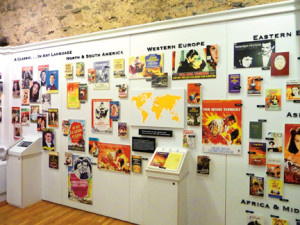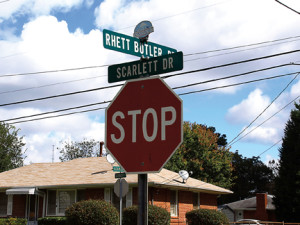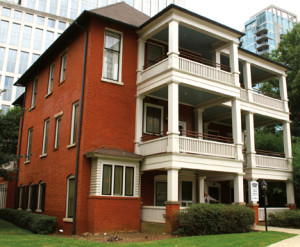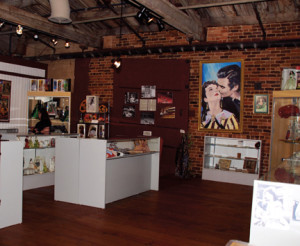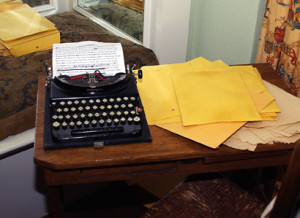On the Trail of “Gone With The Wind”
Posted on March 1, 2014 by bob in Travel
by Andrea Gross; photos by Irv Green
I allow three days to explore the Gone with the Wind (GWTW) Trail in and near Atlanta, but it takes me only one to become a Windie. A Windie is a die-hard GWTW fan, a person immersed in the history, legends and legacy surrounding the Pulitzer Prize-winning novel and enormously popular film. Some dream of Rhett; others dream of Scarlett’s fancy clothes or 17” waist. As for me, I dream of publishing a novel that wins one of the world’s most prestigious awards and is turned into a film that earns me millions.
On the surface, GWTW is the wildly romantic tale of Scarlett O’Hara, a headstrong Southern belle (played by Vivian Leigh in the movie) and her love-hate relationship with Rhett Butler, a dashing, successful opportunist (depicted by Clark Gable). But on a deeper level, GWTW is the story of the American South during and immediately after the Civil War, a time when an entire society was challenged and ultimately transformed.
The book, written by first-time novelist Margaret Mitchell, was released to the public in 1936 and became an overnight sensation. David Selznick produced the movie, which is the highest grossing film in box-office history, earning an estimated $3.3 billion in today’s dollars. To capitalize on the public’s interest, the State of George created a GWTW Trail that leads people to five sites that are in some way connected to the book, the film or the author.
Our first trail stop is in Clayton County, where Mitchell’s relatives had a rural home. As a child, Mitchell visited often and listened intently as her family elders told stories about their experiences during the Civil War. Many of these tales were transformed into scenes in her novel, leading her heirs to dub Clayton County the “Official Home of Gone with the Wind.” (To Mitchell’s dismay, Selznick upgraded the comfortable farmhouse of Mitchell’s memory into Tara, a much grander mansion that he thought would better appeal to movie audiences.)
The Road to Tara Museum has a painting of the old farmhouse, in addition to authentic Civil War items and reproductions of many of the costumes worn in the film, including the green Drapery Dress that Leigh wears in one of the movie’s most memorable scenes. But it’s not until I see the display of foreign edition books that I begin to morph from casual tourist to possible Windie.
GWTW has been translated into more than forty languages and sold in more than fifty countries, from Albania and Burma to North Korea and Serbia. Why are people all over the world so intrigued by a story about a war that took place in America so long ago?
We learn the answer the next day when we visit the Margaret Mitchell House, where the author lived when she began her novel. It takes only a few minutes to see the small apartment, but much longer to peruse the exhibits in the nearby hallway. There, on a large signboard, is a quote by Margaret Mitchell: “If the novel has a theme, it is that of survival.”
Why, of course. GWTW addresses a basic concern: If their old world is “gone with the wind,” how do people create a new one that will work in their new circumstances? This is a question asked by everyone who has ever suffered a hardship, be whatever the cause. When seen in this light, it’s easy to understand the story’s universal and enduring appeal.
Our next stop is Atlanta’s Public Library, where there are more than 1,500 of Mitchell’s personal items, including her old Remington typewriter and 1937 Pulitzer Prize certificate.
We’re even more fascinated by the items on display at the Marietta GWTW Museum, Scarlett on the Square, which holds a treasure-trove of photos and ephemera. I examine the film contracts. Gable got $160,000 plus a bonus that enabled him to divorce his wife and marry Carole Lombard, the love of his real life. On the other hand, his co-star Vivian Leigh got a mere $30,000. Yes, Gable was a mega-star, but still, I can’t help but wonder what Mitchell, who was quite the feminist for her time, thought of that.
Finally, we double back to Atlanta to visit Oakland Cemetery, where Mitchell is buried next to her husband. Her tombstone is small compared to many and gives no hint of her fame. It’s simply inscribed with her married name, Margaret Mitchell Marsh. Someone, a Windie no doubt, has decorated the grave with pink flowers, reputedly Mitchell’s favorite color.
I want to extend my stay in Georgia, to delve more deeply into the GWTW phenomena and to learn more about the era in which the novel is set. But we have a plane to catch, so I console myself by remembering Scarlett’s words, “Tomorrow is another day.” I’ll be back.
For more information, visit www.gwtwtrail.com.











